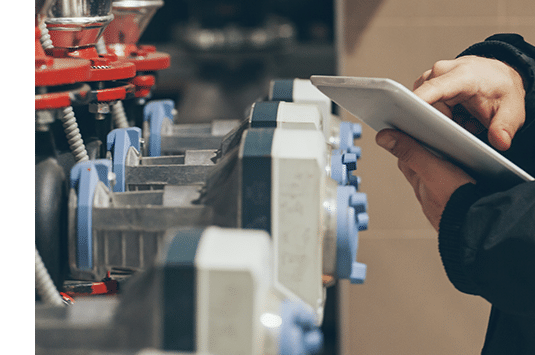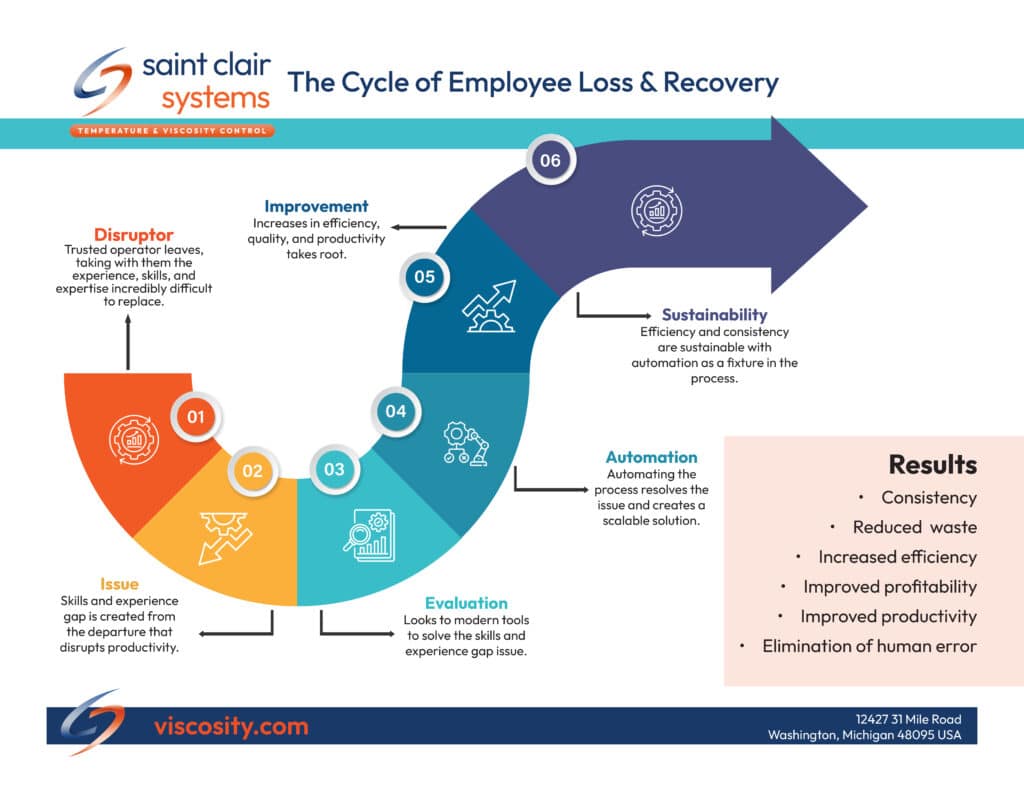Automated Viscosity Control Can Fill the Void
We, at Saint Clair Systems, are temperature and viscosity control experts. Our technology provides an innovative solution for fluid dispensing systems to have greater control over viscosity and consistency.
The Sunset of Manually Measuring Viscosity

Recently, we visited a coating process in a plant in the southeastern part of the United States to evaluate where we could improve efficiency. The plant manager gave us a tour of the process, and then we made it back to his office where we convened with him and several of his more senior operators. The solution we offered the group was to automate their viscosity measurement and control process.
The plant manager looked at me and said, “Man, [manually measuring and controlling viscosity] is like grandma’s cooking. Sure, you can teach these younger guys how to measure, what signs to look for, and how to make adjustments; but they just don’t have the feel or skills like our seasoned operators. It’s not going to be the same result.”
“I’ve been doing this for 47 years,” one of the senior operators then quietly offered up. He then looked at me and advised, “If each one of us, right now, went out onto the line, and manually measured viscosity, we would each return with a different result. We all are going to do it differently.” The room filled with immediate jokes: “You mean like your eyesight going bad!” “Yeah, some of us are a little less patient with the stopwatch than others.”
The 47-year operator patiently considered the upside of automating the process with viscometers, sensors and controllers. He concluded, “What you’re talking about, automating that whole process where you can get an accurate reading of viscosity, around-the-clock, with adjustments made in real time, that’s incredible.”
Widening Gap Between Retiring Operators and Replacements
The reality is that plant managers and production supervisors are experiencing a troubling trend across the country: seasoned operators, like the gentleman above, are retiring, and younger workers entering the industry aren’t skilled and experienced enough to replace them. And there aren’t enough capable young workers looking to fulfill these roles.
Many operators have half a century of experience in maintaining optimal viscosity. They know what happens when they don’t maintain it; they know how to spot problematic patterns and troubleshoot. Their way of doing things is firmly entrenched in the facility’s culture. These factors have kept the process smooth for all these years.
But these folks are retiring, and conditions in manufacturing have shifted. For reasons we won’t go into in this article, there just aren’t enough younger people lining up to learn these skills and dedicate themselves in the same way previous generations have.
The older system is no longer feasible. So this is creating an issue for managers.
The Old School Way
What typically happens in manual viscosity measurement and control is:
- Hourly Zahn cup measurement by an operator throughout their shift.
- Manual adjustment by that operator using solvent or other means at their discretion.
- Multiple operators conduct their version of the process using their discretion.
- Human error and variance compounds fluid integrity over time.
This is not an efficient system in Industry 4.0, and is not adhering to the principles of lean manufacturing.
The Solution is Automation
Burying our heads in the sand might be tempting, as is wishing it away, but that’s not the way to stay competitive in the industrial world.
Industry 4.0 is flooded with quickly evolving mechanisms like sleek robotic arms, futuristic smart systems, and progressive technology. Manufacturing relies on continuously improving your process to increase efficiency and productivity while removing waste. And automation is a key ingredient in achieving these results.
But we often see viscosity control overlooked - even in the most advanced facilities. And therein lies the solution: automating viscosity control in your process.
How Does Automating Viscosity Control Work?
We use viscometers, sensors, and controllers that work together independent from an operator’s assistance. Instead of once an hour manual measurements, you receive around the clock viscosity readings. You have remote access to this information.
The controller installed will then make the necessary adjustments to viscosity as needed. Once viscosity goes outside the preset parameters, adjustments are made in real time.
Reliance on the feel, skills, and experience of a dependable work force is alleviated in this area. Your younger workers are now freed up to focus on other areas in your process.
Here are some key takeaway benefits of automating viscosity and temperature control in your process:
- Consistency and precision: reduce or eliminate human error.
- Data-driven decision making: 24/7 data, trends and patterns make it easy to stay proactive.
- Reduced reliance on human skill: a younger workforce can easily follow this automated system.
Remote monitoring and control: wherever you have Wifi access, you have system access. Simple as that.


